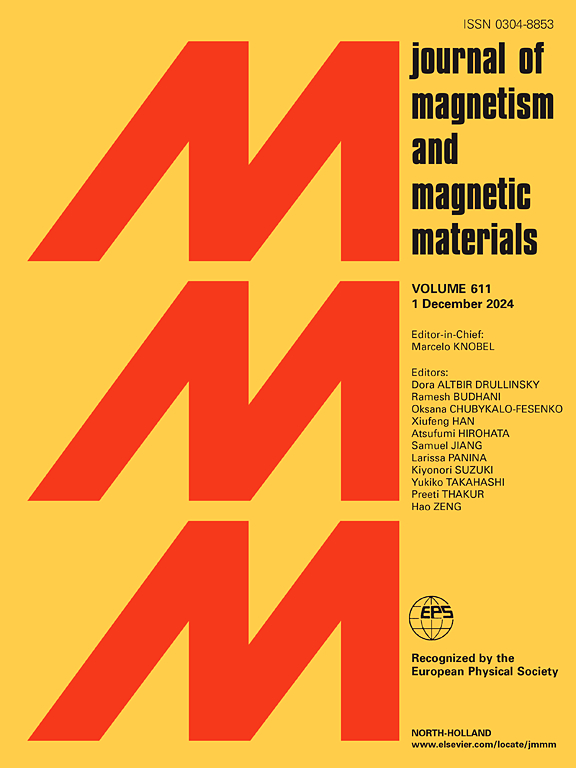tm掺杂CdTe纳米片的电子、光学和磁性:第一性原理计算
IF 2.5
3区 材料科学
Q3 MATERIALS SCIENCE, MULTIDISCIPLINARY
引用次数: 0
摘要
利用密度泛函理论(DFT)研究了取代掺杂过渡金属(Cr, Mn, Fe, Co, V, Cu)的二维(2D) CdTe纳米片(N.S.)的电子、磁性和光学性质。为了确定稳定的磁相,对掺杂纳米片的总能量进行了各种铁磁和反铁磁构型的优化。研究结果表明,虽然原始纳米片具有非磁性、宽带隙(3.28 eV)的半导体特性,但过渡金属原子的掺杂引起磁矩,导致掺杂剂及其邻近原子周围的结构重建。Cr和共掺杂的CdTe纳米片表现出100%的自旋极化,由于其强大的半金属铁磁性,是自旋电子器件的有希望的候选材料。计算了纯掺杂和过渡金属掺杂CdTe纳米片沿z轴的光谱随波长(λ)的变化规律。计算的光学性质包括复介电函数和吸收作为波长的函数。这些有趣的结果表明,tm掺杂的CdTe纳米片在基于低维纳米结构的纳米器件和自旋电子器件中具有潜在的应用前景。本文章由计算机程序翻译,如有差异,请以英文原文为准。
Electronic, optical and magnetic properties of TM-doped CdTe nanosheet: First-principles calculations
The electronic, magnetic, and optical properties of two-dimensional (2D) CdTe nanosheets (N.S.) with substitutional doping of transition metal atoms (Cr, Mn, Fe, Co, V, Cu) were investigated using density functional theory (DFT). To determine the stable magnetic phases, the total energies of doped nanosheets were optimized for various ferromagnetic and antiferromagnetic configurations. The findings reveal that, while the pristine nanosheet exhibits a non-magnetic, wide-bandgap (3.28 eV) semiconductor behavior, doping with transition metal atoms induces magnetic moments, leading to structural reconstruction around the dopant and its neighboring atoms. The Cr- and Co-doped CdTe nanosheets, exhibiting 100 % spin polarization, are promising candidates for spintronic devices due to their strong half-metallic ferromagnetic properties. The optical spectra of both pure and transition metal-doped CdTe nanosheets were calculated along the z-axis as a function of wavelength (λ). The computed optical properties include the complex dielectric function and absorption as a function of wavelength. These interesting results suggest that TM-doped CdTe nanosheets hold potential for applications in nanodevices and spintronic devices based on low-dimensional nanostructures.
求助全文
通过发布文献求助,成功后即可免费获取论文全文。
去求助
来源期刊

Journal of Magnetism and Magnetic Materials
物理-材料科学:综合
CiteScore
5.30
自引率
11.10%
发文量
1149
审稿时长
59 days
期刊介绍:
The Journal of Magnetism and Magnetic Materials provides an important forum for the disclosure and discussion of original contributions covering the whole spectrum of topics, from basic magnetism to the technology and applications of magnetic materials. The journal encourages greater interaction between the basic and applied sub-disciplines of magnetism with comprehensive review articles, in addition to full-length contributions. In addition, other categories of contributions are welcome, including Critical Focused issues, Current Perspectives and Outreach to the General Public.
Main Categories:
Full-length articles:
Technically original research documents that report results of value to the communities that comprise the journal audience. The link between chemical, structural and microstructural properties on the one hand and magnetic properties on the other hand are encouraged.
In addition to general topics covering all areas of magnetism and magnetic materials, the full-length articles also include three sub-sections, focusing on Nanomagnetism, Spintronics and Applications.
The sub-section on Nanomagnetism contains articles on magnetic nanoparticles, nanowires, thin films, 2D materials and other nanoscale magnetic materials and their applications.
The sub-section on Spintronics contains articles on magnetoresistance, magnetoimpedance, magneto-optical phenomena, Micro-Electro-Mechanical Systems (MEMS), and other topics related to spin current control and magneto-transport phenomena. The sub-section on Applications display papers that focus on applications of magnetic materials. The applications need to show a connection to magnetism.
Review articles:
Review articles organize, clarify, and summarize existing major works in the areas covered by the Journal and provide comprehensive citations to the full spectrum of relevant literature.
 求助内容:
求助内容: 应助结果提醒方式:
应助结果提醒方式:


